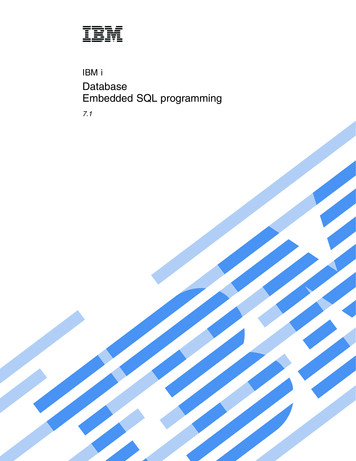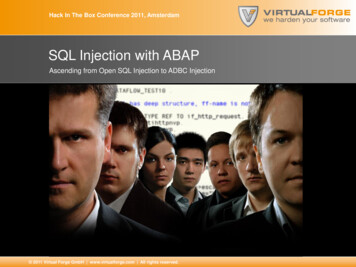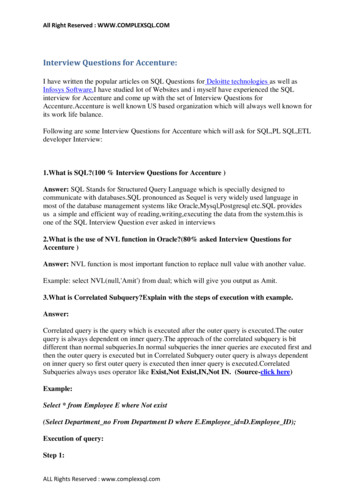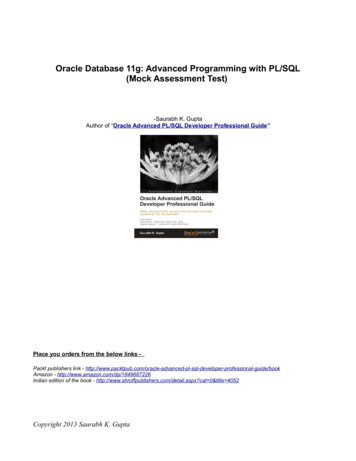
Transcription
IBMIBM iDatabaseEmbedded SQL programming7.1
IBMIBM iDatabaseEmbedded SQL programming7.1
NoteBefore using this information and the product it supports, read the information in “Notices,” onpage 191.This edition applies to IBM i 7.1 (product number 5770-SS1) and to all subsequent releases and modifications untilotherwise indicated in new editions. This version does not run on all reduced instruction set computer (RISC)models nor does it run on CISC models. Copyright IBM Corporation 1998, 2010.US Government Users Restricted Rights – Use, duplication or disclosure restricted by GSA ADP Schedule Contractwith IBM Corp.
ContentsEmbedded SQL programming . . . . . 1What's new for IBM i 7.1 . . . . . . . . . . 1PDF file for Embedded SQL programming . . . . 1Common concepts and rules for using embeddedSQL . . . . . . . . . . . . . . . . . 2Writing applications that use SQL . . . . . . 2Using host variables in SQL statements . . . . 2Assignment rules for host variables in SQLstatements . . . . . . . . . . . . . 4Indicator variables in applications that use SQL 4Indicator variables used with host structures 5Indicator variables used to assign specialvalues . . . . . . . . . . . . . 5Handling SQL error return codes using theSQLCA . . . . . . . . . . . . . . . 7Using the SQL diagnostics area . . . . . . . 7Updating applications to use the SQLdiagnostics area . . . . . . . . . . . 8IBM i programming model . . . . . . . 8Additional notes on using the SQL diagnosticsarea . . . . . . . . . . . . . . . 8Example: SQL routine exception . . . . . . 9Example: Logging items from the SQLdiagnostics area . . . . . . . . . . . 9Handling exception conditions with theWHENEVER statement . . . . . . . . . 10Coding SQL statements in C and C applications11Defining the SQL communication area in C andC applications that use SQL . . . . . . . 11Defining SQL descriptor areas in C and C applications that use SQL. . . . . . . . . 13Embedding SQL statements in C and C applications that use SQL. . . . . . . . . 15Comments in C and C applications that useSQL . . . . . . . . . . . . . . . 15Continuation for SQL statements in C andC applications that use SQL . . . . . . 15Including code in C and C applications thatuse SQL . . . . . . . . . . . . . 16Margins in C and C applications that useSQL . . . . . . . . . . . . . . . 16Names in C and C applications that useSQL . . . . . . . . . . . . . . . 16NULLs and NULs in C and C applicationsthat use SQL . . . . . . . . . . . . 16Statement labels in C and C applicationsthat use SQL . . . . . . . . . . . . 16Preprocessor sequence for C and C applications that use SQL. . . . . . . . 16Trigraphs in C and C applications that useSQL . . . . . . . . . . . . . . . 17WHENEVER statement in C and C applications that use SQL. . . . . . . . 17Using host variables in C and C applicationsthat use SQL . . . . . . . . . . . . . 17 Copyright IBM Corp. 1998, 2010 Declaring host variables in C and C applications that use SQL. . . . . . . .Numeric host variables in C and C applications that use SQL. . . . . . .Character host variables in C and C applications that use SQL. . . . . . .Graphic host variables in C and C applications that use SQL. . . . . . .Binary host variables in C and C applications that use SQL. . . . . . .LOB host variables in C and C applications that use SQL. . . . . . .XML host variables in C and C applications that use SQL. . . . . . .ROWID host variables in C and C applications that use SQL. . . . . . .Result set locator host variables in C andC applications that use SQL . . . . .Using host structures in C and C applicationsthat use SQL . . . . . . . . . . . . .Host structure declarations in C and C applications that use SQL. . . . . . . .Host structure indicator array in C and C applications that use SQL. . . . . . . .Using arrays of host structures in C and C applications that use SQL. . . . . . . . .Host structure array in C and C applications that use SQL. . . . . . . .Host structure array indicator structure in Cand C applications that use SQL . . . .Using pointer data types in C and C applications that use SQL. . . . . . . . .Using typedef in C and C applications thatuse SQL . . . . . . . . . . . . . .Using ILE C compiler external file descriptions inC and C applications that use SQL. . . . .Determining equivalent SQL and C or C datatypes . . . . . . . . . . . . . . .Notes on C and C variable declaration andusage . . . . . . . . . . . . . .Using indicator variables in C and C applications that use SQL. . . . . . . . .Coding SQL statements in COBOL applications . .Defining the SQL communication area in COBOLapplications that use SQL. . . . . . . . .Defining SQL descriptor areas in COBOLapplications that use SQL. . . . . . . . .Embedding SQL statements in COBOLapplications that use SQL. . . . . . . . .Comments in COBOL applications that useSQL . . . . . . . . . . . . . . .Continuation for SQL statements in COBOLapplications that use SQL. . . . . . . .Including code in COBOL applications thatuse SQL . . . . . . . . . . . . .Margins in COBOL applications that use 54747474848iii
Sequence numbers in COBOL applicationsthat use SQL . . . . . . . . . . . .Names in COBOL applications that use SQLCOBOL compile-time options in COBOLapplications that use SQL. . . . . . . .Statement labels in COBOL applications thatuse SQL . . . . . . . . . . . . .WHENEVER statement in COBOLapplications that use SQL. . . . . . . .Multiple source COBOL programs and theSQL COBOL precompiler . . . . . . . .Using host variables in COBOL applications thatuse SQL . . . . . . . . . . . . . .Declaring host variables in COBOLapplications that use SQL. . . . . . . .Numeric host variables in COBOLapplications that use SQL. . . . . . .Floating-point host variables in COBOLapplications that use SQL. . . . . . .Character host variables in COBOLapplications that use SQL. . . . . . .Graphic host variables in COBOLapplications that use SQL. . . . . . .Binary host variables in COBOLapplications that use SQL. . . . . . .LOB host variables in COBOL applicationsthat use SQL . . . . . . . . . . .XML host variables in COBOL applicationsthat use SQL . . . . . . . . . . .Datetime host variables in COBOLapplications that use SQL. . . . . . .ROWID host variables in COBOLapplications that use SQL. . . . . . .Result set locator host variables in COBOLapplications that use SQL. . . . . . .Using host structures in COBOL applications thatuse SQL . . . . . . . . . . . . . .Host structure in COBOL applications that useSQL . . . . . . . . . . . . . . .Host structure indicator array in COBOLapplications that use SQL. . . . . . . .Using host structure arrays in COBOLapplications that use SQL. . . . . . . .Host structure array in COBOL applicationsthat use SQL . . . . . . . . . . . .Host array indicator structure in COBOLapplications that use SQL. . . . . . . .Using external file descriptions in COBOLapplications that use SQL. . . . . . . . .Using external file descriptions for hoststructure arrays in COBOL applications thatuse SQL . . . . . . . . . . . . .Determining equivalent SQL and COBOL datatypes . . . . . . . . . . . . . . .Notes on COBOL variable declaration andusage . . . . . . . . . . . . . .Using indicator variables in COBOL applicationsthat use SQL . . . . . . . . . . . . .Coding SQL statements in PL/I applications . . .Defining the SQL communication area in PL/Iapplications that use SQL. . . . . . . . .ivIBM i: Database Embedded SQL 06464656969707073737474Defining SQL descriptor areas in PL/Iapplications that use SQL. . . . . . . . .Embedding SQL statements in PL/I applicationsthat use SQL . . . . . . . . . . . . .Example: Embedding SQL statements in PL/Iapplications that use SQL. . . . . . . .Comments in PL/I applications that use SQLContinuation for SQL statements in PL/Iapplications that use SQL. . . . . . . .Including code in PL/I applications that useSQL . . . . . . . . . . . . . . .Margins in PL/I applications that use SQL . .Names in PL/I applications that use SQL . .Statement labels in PL/I applications that useSQL . . . . . . . . . . . . . . .WHENEVER statement in PL/I applicationsthat use SQL . . . . . . . . . . . .Using host variables in PL/I applications that useSQL . . . . . . . . . . . . . . . .Declaring host variables in PL/I applicationsthat use SQL . . . . . . . . . . . .Numeric-host variables in PL/Iapplications that use SQL. . . . . . .Character-host variables in PL/Iapplications that use SQL. . . . . . .Binary host variables in PL/I applicationsthat use SQL . . . . . . . . . . .LOB host variables in PL/I applicationsthat use SQL . . . . . . . . . . .ROWID host variables in PL/I applicationsthat use SQL . . . . . . . . . . .Using host structures in PL/I applications thatuse SQL . . . . . . . . . . . . . .Host structures in PL/I applications that useSQL . . . . . . . . . . . . . . .Host structure indicator arrays in PL/Iapplications that use SQL. . . . . . . .Using host structure arrays in PL/I applicationsthat use SQL . . . . . . . . . . . . .Host structure array in PL/I applications thatuse SQL . . . . . . . . . . . . .Host structure array indicator in PL/Iapplications that use SQL. . . . . . .Using external file descriptions in PL/Iapplications that use SQL. . . . . . . . .Determining equivalent SQL and PL/I data typesUsing indicator variables in PL/I applicationsthat use SQL . . . . . . . . . . . . .Differences in PL/I because of structureparameter passing techniques . . . . . . .Coding SQL statements in RPG/400 applications . .Defining the SQL communication area inRPG/400 applications that use SQL . . . . .Defining SQL descriptor areas in RPG/400applications that use SQL. . . . . . . . .Embedding SQL statements in RPG/400applications that use SQL. . . . . . . . .Example: Embedding SQL statements inRPG/400 applications that use SQL . . . .Comments in RPG/400 applications that useSQL . . . . . . . . . . . . . . 68889898990919191
Continuation for SQL statements in RPG/400applications that use SQL. . . . . . . . 91Including code in RPG/400 applications thatuse SQL . . . . . . . . . . . . . 91Sequence numbers in RPG/400 applicationsthat use SQL . . . . . . . . . . . . 92Names in RPG/400 applications that use SQL 92Statement labels in RPG/400 applications thatuse SQL . . . . . . . . . . . . . 92WHENEVER statement in RPG/400applications that use SQL. . . . . . . . 92Using host variables in RPG/400 applicationsthat use SQL . . . . . . . . . . . . . 92Declaring host variables in RPG/400applications that use SQL. . . . . . . . 92Using host structures in RPG/400 applicationsthat use SQL . . . . . . . . . . . . . 93Using host structure arrays in RPG/400applications that use SQL. . . . . . . . . 93Using external file descriptions in RPG/400applications that use SQL. . . . . . . . . 94External file description considerations forhost structure arrays in RPG/400 applicationsthat use SQL . . . . . . . . . . . . 95Determining equivalent SQL and RPG/400 datatypes . . . . . . . . . . . . . . . 95Assignment rules in RPG/400 applicationsthat use SQL . . . . . . . . . . . . 98Using indicator variables in RPG/400applications that use SQL. . . . . . . . . 98Example: Using indicator variables inRPG/400 applications that use SQL . . . . 98Differences in RPG/400 because of structureparameter passing techniques . . . . . . . 99Correctly ending a called RPG/400 program thatuses SQL . . . . . . . . . . . . . . 99Coding SQL statements in ILE RPG applications . . 99Defining the SQL communication area in ILERPG applications that use SQL . . . . . . 100Defining SQL descriptor areas in ILE RPGapplications that use SQL . . . . . . . . 101Embedding SQL statements in ILE RPGapplications that use SQL . . . . . . . . 102Comments in ILE RPG applications that useSQL . . . . . . . . . . . . . . 103Continuation for SQL statements in ILE RPGapplications that use SQL . . . . . . . 103Including code in ILE RPG applications thatuse SQL . . . . . . . . . . . . . 104Using directives in ILE RPG applications thatuse SQL . . . . . . . . . . . . . 104Sequence numbers in ILE RPG applicationsthat use SQL . . . . . . . . . . . 104Names in ILE RPG applications that use SQL 105Statement labels in ILE RPG applications thatuse SQL . . . . . . . . . . . . . 105WHENEVER statement in ILE RPGapplications that use SQL . . . . . . . 105Using host variables in ILE RPG applicationsthat use SQL . . . . . . . . . . . . 105 Declaring host variables in ILE RPGapplications that use SQL . . . . . . .Declaring binary host variables in ILERPG applications that use SQL . . . .Declaring LOB host variables in ILE RPGapplications that use SQL . . . . . .Declaring XML host variables in ILE RPGapplications that use SQL . . . . . .Declaring ROWID variables in ILE RPGapplications that use SQL . . . . . .Declaring result set locator variables inILE RPG applications that use SQL . . .Using host structures in ILE RPG applicationsthat use SQL . . . . . . . . . . . .Using host structure arrays in ILE RPGapplications that use SQL . . . . . . . .Using external file descriptions in ILE RPGapplications that use SQL . . . . . . . .External file description considerations forhost structure arrays in ILE RPG applicationsthat use SQL . . . . . . . . . . .Determining equivalent SQL and ILE RPG datatypes . . . . . . . . . . . . . . .Notes on ILE RPG variable declaration andusage . . . . . . . . . . . . . .Using indicator variables in ILE RPGapplications that use SQL . . . . . . . .Example: Using indicator variables in ILERPG applications that use SQL . . . . .Example: SQLDA for a multiple row-area fetchin ILE RPG applications that use SQL . . . .Example: Dynamic SQL in an ILE RPGapplication that uses SQL . . . . . . . .Coding SQL statements in REXX applications . .Using the SQL communication area in REXXapplications . . . . . . . . . . . . .Using SQL descriptor areas in REXXapplications . . . . . . . . . . . . .Embedding SQL statements in REXXapplications . . . . . . . . . . . . .Comments in REXX applications that useSQL . . . . . . . . . . . . . .Continuation of SQL statements in REXXapplications that use SQL . . . . . . .Including code in REXX applications that useSQL . . . . . . . . . . . . . .Margins in REXX applications that use SQLNames in REXX applications that use SQLNulls in REXX applications that use SQL . .Statement labels in REXX applications thatuse SQL . . . . . . . . . . . . .Handling errors and warnings in REXXapplications that use SQL . . . . . . .Using host variables in REXX applications thatuse SQL . . . . . . . . . . . . . .Determining data types of input hostvariables in REXX applications that use SQL .The format of output host variables in REXXapplications that use SQL . . . . . . .Avoiding REXX conversion in REXXapplications that use SQL . . . . . . 36136v
Using indicator variables in REXX applicationsthat use SQL . . . . . . . . . . . .Preparing and running a program with SQLstatements . . . . . . . . . . . . . .Basic processes of the SQL precompiler. . . .Input to the SQL precompiler . . . . . .Source file CCSIDs in the SQL precompilerOutput from the SQL precompiler . . . .Listing. . . . . . . . . . . . .Temporary source file members created bythe SQL precompiler . . . . . . . .Sample SQL precompiler output . . . .Non-ILE SQL precompiler commands . . . .Compiling a non-ILE application programthat uses SQL . . . . . . . . . . .ILE SQL precompiler commands . . . . . .Compiling an ILE application program thatuses SQL . . . . . . . . . . . . .Setting compiler options using the precompilercommands . . . . . . . . . . . . .Interpreting compile errors in applications thatuse SQL . . . . . . . . . . . . . .Binding an application that uses SQL . . . .Program references in applications that useSQL . . . . . . . . . . . . . .Displaying SQL precompiler options . . . .Running a program with embedded SQL . . .Running a program with embedded SQL:DDM considerations . . . . . . . . .Running a program with embedded SQL:Override considerations . . . . . . . .viIBM i: Database Embedded SQL 147147147148149149149149Running a program with embedded SQL:SQL return codes . . . . . . . . . .Example programs: Using DB2 for i statements . .Example: SQL statements in ILE C and C programs . . . . . . . . . . . . . .Example: SQL statements in COBOL and ILECOBOL programs . . . . . . . . . . .Example: SQL statements in PL/I programs . .Example: SQL statements in RPG/400 programsExample: SQL statements in ILE RPG programsExample: SQL statements in REXX programsReport produced by example programs that useSQL . . . . . . . . . . . . . . .CL command descriptions for host languageprecompilers . . . . . . . . . . . . .Create SQL COBOL Program command . . .Create SQL ILE COBOL Object command . . .Create SQL ILE C Object command . . . . .Create SQL ILE C Object command . . . .Create SQL PL/I Program command . . . .Create SQL RPG Program command . . . .Create SQL ILE RPG Object command . . . .Related information for Embedded SQLprogramming . . . . . . . . . . . . 89189Appendix. Notices . . . . . . . . . 191Programming interface information .Trademarks . . . . . . . . .Terms and conditions. . . . . . 192. 193. 193
Embedded SQL programmingThis topic collection explains how to create database applications in host languages that use DB2 for iSQL statements and functions.Note: By using the code examples, you agree to the terms of the “Code license and disclaimerinformation” on page 190.What's new for IBM i 7.1Read about new or significantly changed information for the Embedded SQL programming topiccollection. v The C, C , ILE COBOL, and ILE RPG precompilers support an XML host variable type: – “XML host variables in C and C applications that use SQL” on page 27 – “XML host variables in COBOL applications that use SQL” on page 56 – “Declaring XML host variables in ILE RPG applications that use SQL” on page 109 v The C, C , COBOL, and ILE RPG precompilers support result set locator host variable type: – “Result set locator host variables in C and C applications that use SQL” on page 30 – “Result set locator host variables in COBOL applications that use SQL” on page 59 – “Declaring result set locator variables in ILE RPG applications that use SQL” on page 112v The DBGENCKEY (Debug encryption key) parameter is passed to the compiler for ILE programs andservice programs.– “Compiling an ILE application program that uses SQL” on page 146 What's new as of October 2013 v The ILE RPG precompiler supports free-form declarations. – “Determining equivalent SQL and ILE RPG data types” on page 117How to see what's new or changedTo help you see where technical changes have been made, this information uses:v Theimage to mark where new or changed information begins.v Theimage to mark where new or changed information ends.In PDF files, you might see revision bars ( ) in the left margin of new and changed information.To find other information about what's new or changed this release, see the Memo to users.PDF file for Embedded SQL programmingYou can view and print a PDF file of this information.To view or download the PDF version of this document, select Embedded SQL programming.Saving PDF filesTo save a PDF on your workstation for viewing or printing:1. Right-click the PDF link in your browser.2. Click the option that saves the PDF locally. Copyright IBM Corp. 1998, 20101
3. Navigate to the directory in which you want to save the PDF.4. Click Save.Downloading Adobe ReaderYou need Adobe Reader installed on your system to view or print these PDFs. You can download a freecopy from the Adobe Web site (http://get.adobe.com/reader/)Related reference:.“Related information for Embedded SQL programming” on page 189Product manuals and other information center topic collections contain information that relates to theEmbedded SQL programming topic collection. You can view or print any of the PDF files.Common concepts and rules for using embedded SQLHere are some common concepts and rules for using SQL statements in a host language.Writing applications that use SQLYou can create database applications in host languages that use DB2 for i SQL statements and functions.To use embedded SQL, you must have the licensed program IBM DB2 Query Manager and SQLDevelopment Kit for i installed. Additionally, you must have the compilers for the host languages youwant to use installed.Related concepts:“Coding SQL statements in C and C applications” on page 11To embed SQL statements in an ILE C or C program, you need to be aware of some unique applicationand coding requirements. This topic also defines the requirements for host structures and host variables.“Coding SQL statements in COBOL applications” on page 44There are unique application and coding requirements for embedding SQL statements in a COBOLprogram. In this topic, requirements for host structures and host variables are defined.“Coding SQL statements in PL/I applications” on page 74There are some unique application and coding requirements for embedding SQL statements in a PL/Iprogram. In this topic, requirements for host structures and host variables are defined.“Coding SQL statements in RPG/400 applications” on page 89The RPG/400 licensed program supports both RPG II and RPG III programs.“Coding SQL statements in ILE RPG applications” on page 99You need to be aware of the unique application and coding requirements for embedding SQL statementsin an ILE RPG program. In this topic, the coding requirements for host variables are defined.“Coding SQL statements in REXX applications” on page 128REXX procedures do not have to be preprocessed. At run time, the REXX interpreter passes statementsthat it does not understand to the current active command environment for processing.“Preparing and running a program with SQL statements” on page 137This topic describes some of the tasks for preparing and running an application program.IBM Developer Kit for JavaUsing host variables in SQL statementsWhen your program retrieves data, the values are put into data items that are defined by your programand that are specified with the INTO clause of a SELECT INTO or FETCH statement. The data items arecalled host variables.2IBM i: Database Embedded SQL programming
A host variable is a field in your program that is specified in an SQL statement, usually as the source ortarget for the value of a column. The host variable and column must have compatible data types. Hostvariables cannot be used to identify SQL objects, such as tables or views, except in the DESCRIBE TABLEstatement.A host structure is a group of host variables used as the source or target for a set of selected values (forexample, the set of values for the columns of a row). A host structure array is an array of host structuresthat is used in the multiple-row FETCH and blocked INSERT statements.Note: By using a host variable instead of a literal value in an SQL statement, you give the applicationprogram the flexibility to process different rows in a table or view.For example, instead of coding an actual department number in a WHERE clause, you can use a hostvariable set to the department number you are currently interested in.Host variables are commonly used in SQL statements in these ways:v In a WHERE clause: You can use a host variable to specify a value in the predicate of a searchcondition, or to replace a literal value in an expression. For example, if you have defined a field calledEMPID that contains an employee number, you can retrieve the name of the employee whose numberis 000110 with:MOVE ’000110’ TO EMPID.EXEC SQLSELECT LASTNAMEINTO :PGM-LASTNAMEFROM CORPDATA.EMPLOYEEWHERE EMPNO :EMPIDEND-EXEC.v As a receiving area for column values (named in an INTO clause): You can use a host variable tospecify a program data area that is to contain the column values of a retrieved row. The INTO clausenames one or more host variables that you want to contain column values returned by SQL. Forexample, suppose you are retrieving the EMPNO, LASTNAME, and WORKDEPT column values fromrows in the CORPDATA.EMPLOYEE table. You could define a host variable in your program to holdeach column, then name the host variables with an INTO clause. For example:EXEC SQLSELECT EMPNO, LASTNAME, WORKDEPTINTO :CBLEMPNO, :CBLNAME, :CBLDEPTFROM CORPDATA.EMPLOYEEWHERE EMPNO :EMPIDEND-EXEC.In this example, the host variable CBLEMPNO receives the value from EMPNO, CBLNAME receivesthe value from LASTNAME, and CBLDEPT receives the value from WORKDEPT.v As a value in a SELECT clause: When specifying a list of items in the SELECT clause, you are notrestricted to the column names of tables and views. Your program can return a set of column valuesintermixed with host variable values and literal constants. For example:MOVE ’000220’ TO PERSON.EXEC SQLSELECT "A", LASTNAME, SALARY, :RAISE,SALARY :RAISEINTO :PROCESS, :PERSON-NAME, :EMP-SAL,:EMP-RAISE, :EMP-TTLFROM CORPDATA.EMPLOYEEWHERE EMPNO :PERSONEND-EXEC.The results 29840447634316Embedded SQL programming3
v As a value in other clauses of an SQL statement:– The SET clause in an UPDATE statement– The VALUES clause in an INSERT statement– The CALL statementRelated concepts:DB2 for i5/OS SQL referenceAssignment rules for host variables in SQL statementsSQL values are assigned to host variables during the running of FETCH, SELECT INTO, SET, andVALUES INTO statements. SQL values are assigned from host variables during the running of INSERT,UPDATE, and CALL statements.All assignment operations observe the following rules:v Numbers and strings are compatible:– Numbers can be assigned to character or graphic string columns or host variables.– Character and graphic strings can be assigned to numeric columns or numeric host variables.v All character and DBCS graphic strings are compatible with UCS-2 and UTF-16 graphic columns ifconversion is supported between the CCSIDs. All graphic strings are compatible if the CCSIDs arecompatible. All numeric values are compatible. Conversions are performed by SQL whenevernecessary. All character and DBCS graphic strings are compatible with UCS-2 and UTF-16 graphiccolumns for assignment operations, if conversion is supported between the CCSIDs. For the CALLstatement, character and DBCS graphic parameters are compatible with UCS-2 and UTF-16 parametersif conversion is supported.v Binary strings are only compatible with binary strings.v A null value cannot be assigned to a host variable that does not have an associated indicator variable.v Different types of date/time values are not compatible. Dates are only compatible with dates or stringrepresentations of dates; times are only compatible with times or string representations of times; andtimestamps are only compatible with timestamps or string representations of timestamps.Related concepts:i5/OS globalizationRelated reference:DECLARE VARIABLENumeric assignmentsString assignmentsDatetime assignmentsIndicator variables in applications that use SQLAn indicator variable is a halfword integer variable used to communicate additional information about itsassociated host variable.v If the value for the result column is null, SQL puts a -1 in the indicator variable.v If you do not use an indicator variable and the result column is a null value, a negative SQLCODE isreturned.v If the value for the result column causes a data mapping error, SQL sets the indicator variable to -2.You can also use an indicator variable to verify that a retrieved string value has not been truncated. Iftruncation occurs, the indicator variable contains a positive integer that specifies the original length of thestring. If the string represents a large object (LOB), and the original length of the string is greater than32 767, the value that is stored in the indicator variable is 32 767, because no larger value can be storedin a halfword integer.4IBM i: Database Embedded SQL programming
Always test the indicator variable first. If the value of the indicator variable is less than zero, you knowthe value of the result column should not be used. When the database manager returns a null value, thehost variable might or might not be set to the default value for the result column's data type (0 fornumeric, blanks for fixed length character, etc).You specify an indicator variable (preceded by a colon) immediately after the host variable. For example:EXEC SQLSELECT COUNT(*), AVG(SALARY)INTO :PLICNT, :PLISAL:INDNULLFROM CORPDATA.EMPLOYEEWHERE EDLEVEL 18END-EXEC.You can then test INDNULL in your program to see if it contains a negative value. If it does, you knowSQL returned a null value (if its value is -1) or a data mapping error (if its value is -2). If the indicatorvalue is not negative, the value returned in PLISAL can be used.Related reference:PredicatesIndicator variables used with host structures:You can specify an indicator array (defined as an array of halfword integer variables) to support a hoststructure.If the results column values returned to a host structure can be null, you can add an indicator array nameafter the host structure name. This allows SQL to notify your program about each null value returned toa host variable in the host structure.For example, in COBOL:01 SAL-REC.10 MIN-SALPIC S9(6)V99 USAGE COMP-3.10 AVG-SALPIC S9(6)V99 USAGE COMP-3.10 MAX-SALPIC S9(6)V99 USAGE COMP-3.01 SALTABLE.02 SALINDPIC S9999 USAGE COMP-4 OCCURS 3 TIMES.01 EDUC-LEVELPIC S9999 COMP-4.MOVE 20 TO EDUC-LEVEL.EXEC SQLSELECT MIN(SALARY), AVG(SALARY), MAX(SALARY)INTO :SAL-REC:SALINDFROM CORPDATA.EMPLOYEEWHERE EDLEVEL
PDF file for Embedded SQL pr ogramming . . 1 Common concepts and r ules for using embedded SQL . . 2 W riting applications that use SQL . . 2 Using host variables in SQL statements . . 2 Assignment r ules for host variables in SQL










